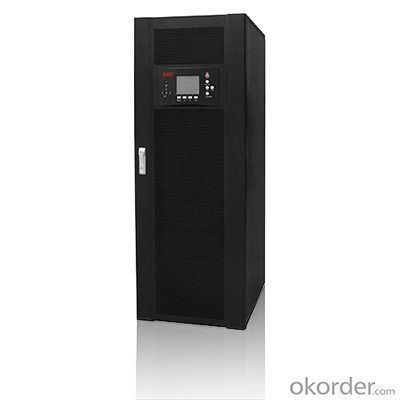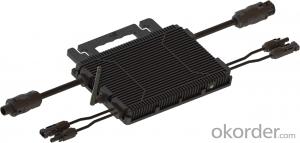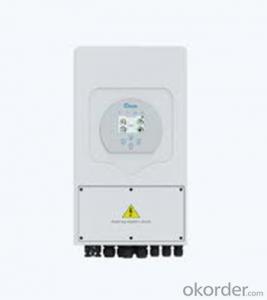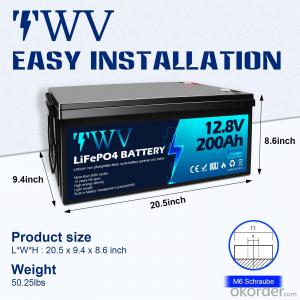Loading Port:China main port
Payment Terms:TT or LC
Min Order Qty:1 pc
Supply Capability:1000 pc/month
Off-Grid Solar Inverter 10KVA-120KVA
EA-GF series products use high speed DSP control unit, advanced high speed IGBT, MOSFET components, with pulse width modulation (SVPWM) technique disturbance type MPPT control, and double conversion system configuration. Under high-speed DSP system control, the system can quickly track panels to do high-power, load change and efficient multi-level control system, even if the mains input voltage and frequency suddenly change, over/under voltage, or power disturbances, it also can ensure provide the load with regulated voltage and frequency power. System has a reliable, environmentally friendly, high intelligence and other characteristics.
Villa, hotel, residential security, large base station, office, small manufacturing enterprises, computing centers, industrial automation equipment, network room, IDC data center, banking equipment, securities, health care, transportation, petrochemical and other solar systems.
● High reliability:
※ High-speed micro-controller DSP digital control technology to achieve real-time control, parameter setting, data detection, self-test function to ensure high reliable operation of the system.
※ With high speed switching characteristic, high voltage, high current, low internal resistance, low dissipation IGBT, MOSFET power components based, to ensure system security and reliability.
● N+1 modularized MPPT tracking system:
※ Multipath MPPT control system access, independent input, operation. More suitable for roof project, to improve power generation efficiency of the panels.
● PV proactive power supply function:
After detects PV energy, system will enter MPPT status automatically, and it will also adjust the power distribution, priority in the use of PV energy.
● Intelligent battery management system:
※ In this system, AC rectifier 、MPPT controller controlled by intelligent data exchange and communication system,user can set the battery capacity by themselves;battery configuration can be set by the operator interface,system will automatically
adjust the charging current ,charging voltage and charging mode.
※ In special cases,international technical engineer can adjust the charging rate and battery number according to the system configuration.
● Plenteous communication interface:
※ RS485、RS232 (standard),SNMP(Option).
※ Input dry contacts to switch on/off inverter, clear abnormal, EPO remotely. Output dry contacts singles for remote alarm.
● Intelligent storage staggering features:
System with intelligent peak load shifting function, the user can set the appropriate time period electricity according to the local electricity policy, to achieve load shifting features directly in order to bring economic value;
Model | 10KVA | 20KVA | 30KVA | 40KVA | 50KVA | 60KVA | 80KVA | 100KVA | 120KVA | |
Rated Power(KW) | 9KW | 18KW | 27KW | 36KW | 45KW | 54KW | 72KW | 90KW | 108KW | |
Rated Current (A) | 15A | 30A | 45A | 60A | 76A | 91A | 133A | 151A | 182A | |
Output Power Factor | 0.9 | |||||||||
Rated Input Voltage | 380V±20% | |||||||||
Rated Output Voltage | 380V±1% | |||||||||
Battery Voltage | 360Vdc | |||||||||
Battery Quantity | 30 units, 12V | |||||||||
Working Mode | PV、AC replenish | |||||||||
PV Input | Max Voltage | 750Vdc | ||||||||
Best Working Voltage(Vmp) | 444-550Vdc | |||||||||
Float Charging Voltage | 414V±1% | |||||||||
Max Efficiency | ≥98% | |||||||||
Equalize Charging Voltage | 428V±1% | |||||||||
Max Current | 40A | 60A | 120A | 180A | 240A | 300A | 360A | |||
PV Input Ways | 1+1(reserved) | 2+1(reserved) | 3+1(reserved) | 4+4(reserved) | 5+3(reserved) | 6+2(reserved) | ||||
MPPT Modular | 1+1(reserved) | 2+1(reserved) | 3+1(reserved) | 4+4(reserved) | 5+3(reserved) | 6+2(reserved) | ||||
AC Rectifier | Input Voltage Range | Three phases 380V ±20%(-10%~+20% can charge the battery) | ||||||||
Rated Frequency | 50 Hz / 60Hz(can be set backstage) | |||||||||
Frequency Range | 50Hz/60Hz±5Hz | |||||||||
Soft Start | 0-100% 10s | |||||||||
Power Factor | 0.8 | |||||||||
Float Charging Voltage(20℃) | 410V±1% | |||||||||
Max Voltage | 415V±1% | |||||||||
Max Charging Current(A) Battery Capacity Allowed | 12 | 25 | 38 | 50 | 62 | 75 | 80 | 100 | 120 | |
Inverter | Inverter Voltage | Three phases four lines +G 380Vac | ||||||||
Phase Voltage Setting | 220-230-240Vac(can be set backstage) | |||||||||
Output Voltage Accuracy | ±1% | |||||||||
Voltage Transients Range | ±5% | |||||||||
Transient Recovery Time | 20ms | |||||||||
Rated Frequency | 50Hz/60Hz±1% | |||||||||
Frequency Tracking Range | 50Hz/60Hz±3Hz | |||||||||
Crest Factor | 3:1 | |||||||||
Wave | Pure sine wave | |||||||||
THD | ≤3%(linear load) | |||||||||
Voltage Unbalance Degree | ±3%(100%unbalance load) | |||||||||
Overload | ≥105%-110%: transfer to bypass 1 hours later, recover when reduce load ≥110%-125%: transfer to bypass10 min later, recover when reduce load ≥125%-150%: transfer to bypass 1 min later, recover when reduce load ≥150%: transfer to bypass 10 s later, recover when user confirmed ≥200%: shutdown immediately, recover when user confirmed | |||||||||
Short Circuit | System current limited, shut down immediately, boot by user | |||||||||
Max Efficiency % | ≥90% | ≥91% | ≥92% | ≥92% | ≥93% | ≥93% | ≥93% | ≥93% | ≥93% | |
Bypass | Rated Voltage(V) | Three phases four lines+G 380Vac | ||||||||
Voltage Range | ±20% | |||||||||
Rated Frequency(Hz) | 50/60Hz±5Hz | |||||||||
Max Current | 19 | 38 | 57 | 76 | 95 | 114 | 122 | 152 | 182 | |
Battery Management | End of Discharge | 315VDC | ||||||||
Charging Current Setting | Factory setting is 0.15C10 ; user can set 0.05-0.3 C10 | |||||||||
Charging Current Setting | Equalizing charging and float charging automatically transfer, automatic temperature compensation for battery (when battery detection not connected, default environment temperature) | |||||||||
Staggering Depth of Discharge Settings | 1.85V-2.1V; can be set by user | |||||||||
Transfer Time | Inverter/Bypass Transfer Time | 0ms | ||||||||
Inverter/Bypass Transfer Time | 0ms | |||||||||
Communication Interface | Remote Control Input | Inverter on、off、abnormal clear、emergency power off | ||||||||
PC Monitoring Interface | RS232、RS485、SNMP (optional) | |||||||||
Dry Contact | Bypass input abnormal、rectifier input abnormal、system fault、system warning、 low battery、overload 、fans fault、generator ON/OFF | |||||||||
Environment | Operation Temperature | 0-42℃ | ||||||||
Max. Relative Humidity | 90% (non condensed) | |||||||||
Max. Working Altitude | 1000m (100 m higher, 1% derated; max 4000m) | |||||||||
Other | Cooling Way | Forced ventilation (Fans speed varies with the load) | ||||||||
Noise(1m varies with load and temperature )dB | 65 | |||||||||
Mean Time Between Failures(MTBF) | 200,000 hours | |||||||||
Defend Grade(EN60529) | IP20 | |||||||||
Power Line Input | Bottom | |||||||||
Standard | IEC62040-1-1、EN62109-1:2010, EN62109-2:2011 | |||||||||
Dimensions(WxDxH)mm | 600×700×1750 | 1000×800×1700 | ||||||||
Packing Dimensions(WxDxH)mm | 690×790 ×1850 | 1090×890 ×1800 | ||||||||
Weight | 250 | 280 | 300 | 320 | 345 | 360 | 400 | 420 | 445 | |
· Q. What is an UPS and What it is for ?
An uninterruptible power supply (UPS) is a device that allows your computer or telephone switch or critical equipement to keep running for at least a short time or longer time when the primary power source is lost. It also provides protection from power surges, spikes, brownouts, interference and other unwanted problems on the supported equipment.
· Q. How long the UPS to run when power goes?
This can take 3 paths.
1.You can pick a UPS that is rated for pretty much the full VA you need so it will be running at 100% of capability and will thus last 'n' minutes.
2.You can pick a UPS that is rated at a much higher VA value than you really need so, for example, is running at 50% of capability and will thus last for longer than the UPS from option 1.
3.You can use extra external battery packs to run for longer. If charging capability allows, the more and the bigger batteries you take with, the longer time UPS runs.
or using a generator after about 6 hours, it will be more cost-effective, with a short runtime UPS to bridge the generator start-up gap.





